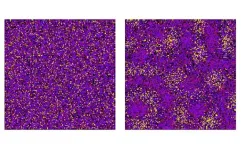(Press-News.org) Researchers at West Virginia University have taken the first steps toward developing technology that can capture carbon dioxide in the air and use it for eco-friendly manufacturing of methanol. The process they have begun modeling — which involves pulling air from buildings — could increase the sustainable supply of methanol, one of the world’s most extensively used raw materials, while removing a planet-warming greenhouse gas from the atmosphere.
Project lead Xingbo Liu, who serves as professor, associate dean for research and chair of engineering at the WVU Benjamin M. Statler College of Engineering and Mineral Resources, explained “methanol, or wood alcohol, has so many applications — it’s one of the most common chemicals in the world. It can be used by itself or as a feedstock for making other products, such as paint, primer or insulation.”
Methanol is typically produced from fossil fuels like shale gas, but Liu and his partners said they believe they have found a way to erase harmful emissions from the production process by harvesting the carbon needed to synthesize methanol from the air of buildings like large apartment or office complexes.
The Phase I project is supported by $400,000 in U.S. Department of Energy funding.
The methanol production system envisioned would hook directly into the existing rooftop HVAC units commonly installed on commercial and residential buildings. The equipment could harvest carbon from the air that gets sucked out of the building by its heating and air conditioning systems.
The equipment could also make its own carbon-free hydrogen, using a rooftop solar panel or other renewable energy source to power solid oxide electrolysis cells, which can split water into oxygen and hydrogen.
A catalyst could combine those hard-to-transport carbon, hydrogen and oxygen gases and turn them into easy-to-transport liquid methanol right on the spot. The methanol could then be piped from the top or side of the building into a tanker truck.
Srinivas Palanki, professor and chair of the Statler College Department of Chemical and Biomedical Engineering, and Debangsu Bhattacharyya, GE Plastics professor, lead the research with Liu in collaboration with industrial partners OxEon Energy, Tennessee Valley Authority and Tallgrass.
Partnering on the project are Edgar Lara-Curzio, Hai-Ying Chen, Michelle Kidder and Kashif Nawaz, researchers with federal energy research facility Oak Ridge National Laboratory, the University’s collaborator in ongoing decarbonization efforts.
Liu said methanol, already in high demand, still has room to grow in new markets.
“Methanol also has the potential to be useful in transportation,” he said. “Now when you go to the gas pumps, you often have the option for ‘flexible fuel,’ which is gasoline mixed with ethanol. Well, you can do something very similar with methanol, replacing the ethanol in a gasoline blend.”
Liu emphasized the process’ low cost and efficiency — not only harvesting carbon from the air but taking the heat it needs to work from the HVAC unit it’s hooked into.
“If you have an air conditioning system that’s located on the ground outside your building, you stay away from it in summer because it’s so hot, right? Really, they provide cold air in the building by making more hot air outside, through waste heat. So now we can use that to our advantage, because the system we’re developing needs that heat.”
The most mature current method for removing carbon from the atmosphere, “point source capture,” is only viable for “huge facilities like coal or natural gas power plants, which release lots of carbon dioxide every hour of every day,” Liu said.
The method he’ll be looking at, “direct air capture,” isn’t a competitor to point source capture. It’s scaled down to work with the volume of carbon emitted through the kinds of rooftop HVAC units found at locations like the WVU Engineering Sciences Building.
Compared to existing direct air capture technologies, Liu expects the system his team is modeling to have significantly lower capital, operational and maintenance barriers to deployment.
“We’re working toward a highly integrated and optimized process with state-of-the-art technologies for direct air capture, electrolysis and methanol synthesis that will lead to cost-efficient production of green methanol that’s more than 99.7% pure,” he said.
“We hope to bring down the cost of technology for carbon dioxide reduction and provide a carbon-neutral solution for producing this common chemical, maximizing the use of captured carbon dioxide and minimizing the environmental footprint.”
END
WVU engineers study how to pull carbon out of building air to make methanol
2023-09-13
ELSE PRESS RELEASES FROM THIS DATE:
LSU Health New Orleans study identifies a potential new approach to PTSD treatment
2023-09-13
New Orleans, LA – An LSU Health New Orleans research study led by Siqiong June Liu, PhD, Professor of Cell Biology and Anatomy, has found that cerebellar inhibitory interneurons are essential for fear memory, a type of emotional memory formation. Inhibitory interneurons within the cerebellar circuitry act as gatekeepers and control the output of the cerebellar cortex. The formation of fear memory requires the activity of these interneurons. The findings, which ...
Scientists find good places to grow long-spined sea urchins, a starting point to restore ‘the lawn mowers of the reefs’
2023-09-13
Scientists call long-spined sea urchins “the lawn mowers of the reefs” because they eat algae that could otherwise smother reef ecosystems and kill corals.
That’s why researchers affiliated with the University of Florida Tropical Aquaculture Lab (TAL), who work at the Florida Aquarium’s Conservation Campus in Apollo Beach, are trying to raise as many urchins as possible.
Aaron Pilnick, a post-doctoral researcher at TAL, led newly published research that identifies substrates that help long-spined sea urchins – scientifically known as Diadema -- ...
Could a breakdown in the brain’s networks allow infections to contribute to Alzheimer’s disease?
2023-09-13
The human microbiome includes the genetic material of more than 100 trillion tiny microorganisms – fungi, yeast, bacteria, and even viruses, most of which hang out in our gastrointestinal tract to serve as guardians of our health. But when a healthy microbiome gives way to an imbalance — a “pathobiome” — any number of health problems can occur — from rheumatoid arthritis, to bacterial vaginosis. New data published this month in the journal Frontiers in Cellular and Infection Microbiology, from researchers at Drexel’s College of Medicine, gives more evidence to the possibility that developing a pathobiome ...
Cleaning products emit hundreds of hazardous chemicals, new study finds
2023-09-13
WASHINGTON – A peer-reviewed study by Environmental Working Group scientists has found unsettling details about the potential health risks of common household cleaning products.
The study, published today in Chemosphere, analyzed 30 cleaning products, including multipurpose and glass cleaners, air fresheners and more. The study revealed that these everyday products may release hundreds of hazardous volatile organic compounds, known as VOCs.
Researchers tested both conventional products and “green” cleaning products and detected a total of 530 unique VOCs in the 30 products. Of these, 193 VOCs were hazardous – identified ...
Statement from the European Respiratory Society on results of the European Parliament vote on revision of the Ambient Air Quality Directive
2023-09-13
Professor Zorana Jovanovic Andersen, Chair of the European Respiratory Society’s Environment and Health Committee and based at the University of Copenhagen, said:
“Today’s vote by the European Parliament to strengthen the legally binding limit values for air quality is an important step in the right direction toward clean air for all, even though the full alignment with World Health Organization was moved from 2030 to 2035. As we prepare for the negotiations with the Council, this is great news for all European citizens, especially the millions who live ...
Majority rule in complex mixtures
2023-09-13
The very first life on earth is thought to have developed from “protocells” – liquid mixtures of many different types of molecules. Researchers from the University of Göttingen have now shown that in such mixtures, small imbalances in the number of molecules of different types can have an unexpected effect. A surprising interplay with the complex pattern of interactions strongly amplifies such imbalances – meaning that a type of molecule that is only slightly in the majority can almost entirely separate out from the others. ...
CHOOSEn fate: one brain organoid’s tale on Autism
2023-09-13
Does the human brain have an Achilles heel that ultimately leads to Autism? With a revolutionizing novel system that combines brain organoid technology and intricate genetics, researchers can now comprehensively test the effect of multiple mutations in parallel and at a single-cell level within human brain organoids. This technology, developed by researchers from the Knoblich group at the Institute of Molecular Biotechnology (IMBA) of the Austrian Academy of Sciences and the Treutlein group at ETH Zurich, ...
Pixel-by-pixel analysis yields insights into lithium-ion batteries
2023-09-13
CAMBRIDGE, MA -- By mining data from X-ray images, researchers at MIT, Stanford University, SLAC National Accelerator, and the Toyota Research Institute have made significant new discoveries about the reactivity of lithium iron phosphate, a material used in batteries for electric cars and in other rechargeable batteries.
The new technique has revealed several phenomena that were previously impossible to see, including variations in the rate of lithium intercalation reactions in different regions of a lithium iron phosphate nanoparticle.
The paper’s most significant practical finding — that ...
Long-term quality of life after out-of-hospital cardiac arrest
2023-09-13
About The Study: In this survey study of 2,552 survivors of cardiac arrest in Denmark, health-related quality of life up to 20 years after the event was consistently high across follow-up periods and comparable to the general Danish population. These findings support resource allocation and efforts targeted to increasing survival after out-of-hospital cardiac arrest.
Authors: Harman Yonis, M.D., of Nordsjallands Hospital in Hillerod, Denmark, is the corresponding author.
To access the embargoed study: Visit our For The Media website at this link https://media.jamanetwork.com/
(doi:10.1001/jamacardio.2023.2934)
Editor’s ...
Economic evaluation of extended-release buprenorphine for persons with opioid use disorder
2023-09-13
About The Study: In this economic evaluation of extended-release buprenorphine compared with transmucosal buprenorphine for the treatment of opioid use disorder, extended-release buprenorphine was not associated with efficient allocation of limited resources when transmucosal buprenorphine was available. Future initiatives should aim to improve retention rates or decrease costs associated with extended-release buprenorphine.
Authors: Juliet M. Flam-Ross, B.A., of the London School of Hygiene and Tropical Medicine in London, and Sabrina A. Assoumou, M.D., M.P.H., of the Boston ...




